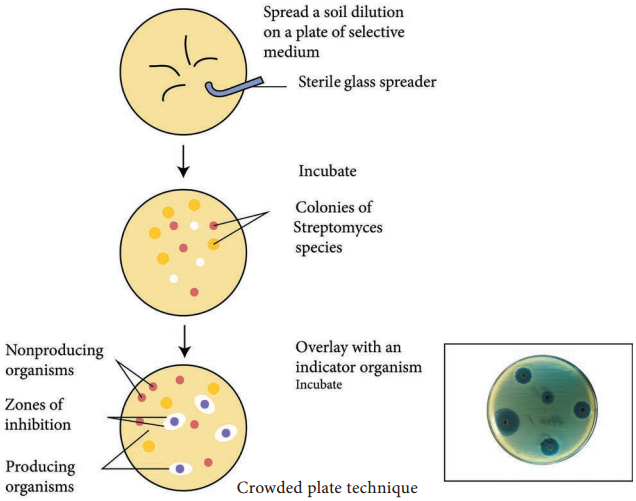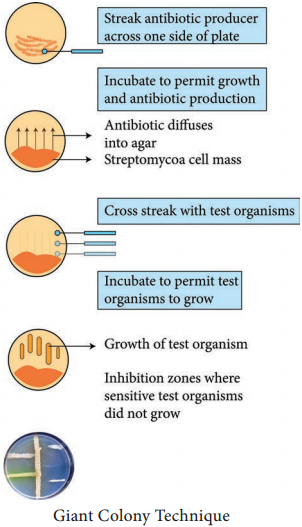Learninsta presents the core concepts of Microbiology with high-quality research papers and topical review articles.
Screening of Industrially Important Microorganism
Isolation of industrially important microorganisms
Success of fermentation depends upon the isolation of microorganism. The microorganisms are isolated from their natural habitats like soil, lakes, river mud or even in unusual habitats or environments such as extreme cold, high altitude, deserts, and deep sea and petroleum fields and are tested directly for the product formation and isolated or it can be genetically modified.
Different types of microorganisms are isolated by different methods. Different microbes with desired activity are isolated using various culture techniques. The next step after isolation of microorganisms is the selection or screening. For the successful fermentation process, selection of microorganisms is the prime important step. Screening includes primary screening and secondary screening.
Primary screening:
The elementary steps that are performed to select the desired organisms and eliminate the undesirable organisms are termed as primary screening. Methods such as crowded plate technique, auxanography and enrichment culture technique are some of the techniques used in primary screening. For screening of antibiotic producing organisms crowded plate technique is described here,
Crowded plate technique
- Soil is serially diluted
- The serially diluted sample is spread on the nutrient agar plates
- The plates are incubated and the agar plate having 300 to 400 colonies are observed for antibiotic producing activity
- The ability of a colony to exhibit antibiotic activity is indicated by the presence of a zone of inhibition surrounding the colony
- The technique is improved by using test organism
- The antibiotic produced by the organisms in the soil may inhibit the growth of test organism
- The formation of inhibitory zones around certain colonies indicates their antibiotic sensitivity
- The diameter of the zones of inhibition is measured in millimeters. Crowded plate technique is depicted in the diagram (Figure 6.3).

Enrichment isolation
The process of enrichment provides a suitable condition to support the growth of microorganisms. It allows the growth of the specific microbe while inhibiting the other non-target microbe. The growth of target microorganisms is enriched by providing sole carbon source.
For screening microorganisms degrading the compound, different inhibitors are employed which have the ability to block a specific metabolic pathway of the non-target microbe.
pH and temperature are also adjusted favoring the growth of desired microorganisms. Soil Calcium carbonate enrichment technique is used for isolation of secondary metabolite producing microorganisms (actinomycetes).
Secondary screening
It is very useful in sorting out microorganisms that have real commercial value from many isolates obtained during primary screening.
1. As primary screening allows the detection and isolation of microorganisms which posses, potentially interesting industrial applications. It is further followed by secondary screening, to check the capabilities and gain information about these organisms.
2. Through primary screening only few or many microorganism that produce a industrially important product, are isolated. The information about the product formed is very less. So, through secondary screening, further sorting out is performed. In this method, only microorganisms with real commercial
value are selected and those that lack the potential are discarded.
3. Secondary screening should yield the types of information which are needed in order to evaluate the true potential of a microorganisms industrially usage.
4. Secondary screening may be qualitative and quantitative in its approach.
5. It is done by using paper, thin layer or other chromatographic techniques.
6. The product’s physical, clinical, and biological properties are determined.
7. It detects gross genetic instability in microbial cultures.
8. It gives information about the number of products produced in a single fermentation.
9. It determines the optimum conditions for growth or accumulation of a product associated with particular culture.
10. It gives information about the different components of the fermentation medium.
11. It helps in providing information regarding the product yield potential of different isolates.
12. It reveals whether microorganisms are capable of a chemical change or it destroys their fermentation product.
There are various methods employed for secondary screening which includes test conducting on petridish containing solid media or by using flasks or small fermentors containing liquid media, giant colony technique, and filtration method liquid medium method (using Erlenmeyer flask). Here giant colony technique is explained in detail.
Giant Colony Technique
The Streptomyces culture is inoculated onto the central areas of petriplates containing a nutritious agar medium or they are streaked in a narrow band across the centre of plates. The plates are then incubated until growth and possibly, sporulation have occurred. Strains of micro organisms to be tested for possible
sensitivity to the antibiotics (the test organisms) are then streaked from the edges of the plates up to but not touching the Streptomycete growth.
The plates are further incubated to allow the growth of the test organism. The growth of the test organism inhibited by antibiotic in the vicinity of the Streptomycete is then measured in millimeters. These Streptomycetes that have produced antibiotics with observable microbial inhibition spectrum are retained for further testing (Figure 6.4).

The microbes used in the industrial microbiology should have following characters.
- The strain should be a high-yielding strain.
- The strain should have stable biochemical and genetical characteristics.
- It should not produce undesirable substances.
- It should be easily cultivated on large scale.
The strain should be in pure culture, free from other microorganisms including Bacteriophages. These characters are screened for the production of desirable products from microorganisms.